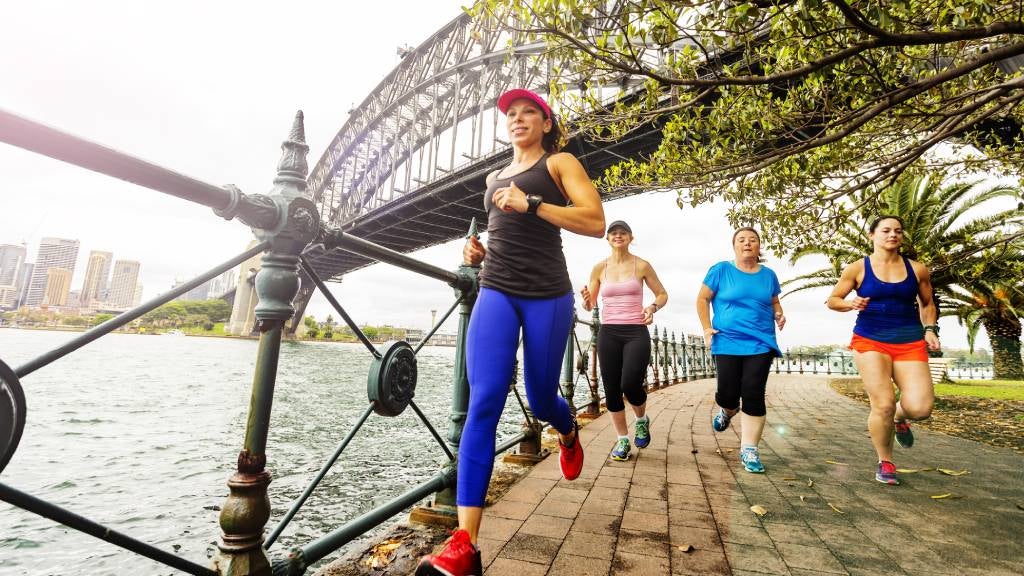Running after getting COVID – A guide to get your energy back

Life is slowly returning to normal post COVID-19, with sporting events returning to calendars such as the Real Insurance Sydney Harbour 10k and 5k on Sunday 24 July. You might be getting itchy feet to compete, but if you’ve tested positive for COVID-19 and are still not feeling 100%, this guide may help you get your energy back.
Internationally recognised sports medicine physician, bestselling author, and fitness instructor, Dr, Jordan D Metzl – whose priority is to help athletes return quickly and safely to their sport – has published guidelines on returning to exercise following COVID-19. These guidelines can be helpful for runners who are unsure how to get back into training without overdoing it.
Because of the unpredictable nature of COVID-19, Dr Jonathan Kim, Sport Cardiologist co-author of the ACC return to play guidelines recommends taking a cautious approach to training, because there is still a lack of knowledge in the role of cardiac injury in relation to coronavirus.
Due to the lack of scientific data in relation to cardiac stress, runners are recommended to allow at least 10 days for a full recovery, slowly returning to activity, and to not just rush out and compete in a gruelling marathon or fun run without rest. The guidelines suggest lingering or moderate symptoms should be evaluated by a medical professional before lacing up your running shoes and pounding the pavement.
While you are still sick, regardless of severity, you should abstain from exercise. “If you test positive in the setting of being exposed, the idea is to wait because we know that when symptoms evolve, they can sometimes evolve pretty dramatically after the first week. Once you know you have it, you need to socially isolate and not exercise,” Dr. Kim said.
“In the old days, it was like: You don't feel that great, go out and go for a run. You'll perk up, you'll feel better,” Dr. Metzl, who besides specialising in sports medicine is also an avid marathon runner and triathlete. “But I think until we know more about this disease, things like exercising when you're not feeling so hot are really not very good ideas for some of these complications that can come when people push too hard on a body that's trying to recover from COVID. This seems to make it worse in some cases.”
These guidelines may help get you back on track after recovering from COVID-19
Pay attention to how you feel during exercise
Any unusual symptoms such as excessive shortness of breath or getting winded during a workout that would normally be easy, extreme fatigue, light-headiness, chest tightness or passing out are all signs you’re not ready for running yet.[1]
Use the 50/30/20 rule
Your first week back training, you should reduce your normal distance and effort by 50%. So, if you’re used to running 5km, half it to 2.5km for seven days and instead of pushing yourself for your personal best, pull back on your speed and take it easier than you usually would. After the first week, if you’re feeling good and haven’t experienced any symptoms, boost your training efforts so you’re giving it 30% more effort. For example, add on another 1.5km to the 2.5km you’re already running and increase your speed a little. Week three increase your efforts by a further 20%, so come week five, if you’re still not experiencing any strange or new symptoms, you can resume your regular training. [2]
Check in with your doctor
This is important for COVID-19 patients who experienced heart complications. “While regular exercise improves cardiovascular health in the long-term, each session of exercise stresses the heart and can trigger potentially lethal arrhythmias in the context of underlying cardiovascular disease,” according to Dr. Metzl. A cardiologist may have to sign off or monitor any return to exercise. [3]
Go low intensity
Intense exercise should be avoided in those experiencing muscle aches and pains or muscle fatigue. Paracetamol may also be helpful for pain control. Fatigue is commonly reported in addition to muscles aches and pains and may last for weeks. Return to exercise should be guided by symptoms and one week of low-intensity exercise is recommended. [4]
Keep hydrated
For runners who suffered with gastrointestinal symptoms as part of COVID-19, fluid and calorie intake should be monitored while you’re experiencing symptoms, and as you return to running. [5]
Get tested
If you have cold or flu symptoms, get tested for Covid-19 before you get back to exercise. If you think you might have had COVID-19, take a RAT or PCR test and if you are worried, consult with your doctor about when you can safely return to exercising. You can also view government health pages for more information.
You are the best judge of how you are feeling, listen to your body, stop exercise if symptoms persist and apply these guidelines when you are training for the Real Insurance Sydney 10k and 5k or any other running event.
Real Insurance is proud to sponsor the Sydney Harbour 10K and 5K. Click here to learn more or to register.
22 Jun 2022
References
Source: Metzl, J.D., McElheny, K., Robinson, J.N. et al. Considerations for Return to Exercise Following Mild-to-Moderate COVID-19 in the Recreational Athlete. HSS Jrnl 16, 102–107 (2020). https://doi.org/10.1007/s11420-020-09777-1